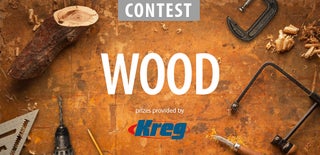Introduction: 42oz Wooden Beer Mug
This idea started while sitting and watching the Hobbit movie. When I saw these bearded dudes standing around with their wooden beer mugs in hand, I thought, "I've gotta design one of my own to hold a lot of beer!" Because of a previous wooden drum project, I already had a Rocker 11.25° Chamfer router bit [useful for making barrels, drums, etc...], so I thought it would be perfect for this project. When using this specific router bit, you get 16 staves that fit together into a mug. Works great. While not exactly the angled Hobbit mug from the movie, my mug still gets the job done! They have been great gifts for my friends and family for Christmas and for a friend retiring from 38+ years of teaching. Since they take a wee bit of time to make, the present has been well received indeed.
[ Note: If you are going to attempt this project, may I humbly suggest making two mugs [or more] so that you can raise a Wooden Mug with a close friend. When I make these mugs, I usually make about four at at time and do the 'assembly line' idea. This saves a tremendous amount of time rather than taking one mug all the way through the process. Total time for one mug: Not sure, but probably ~20+ hours.... The fun is in the process. Go slow, It's not a race. Enjoy the build and the sawdust....].
Quick Overview:
- Cut strips of wood on table saw
- Rout the strips w/ the 11.25° chamfer bit
- Plane down the strips
- Miter cut the strips to length
- Glue up the strips and wrap with screen spline to hold
- Scroll saw the bottom and glue/insert into mug
- Seal bottom with beeswax [inside/outside]or Brewer's Pine Pitch
- Sand mug [bottom/sides]
- Rout bottom and upper rim [inside & outside]
- Scrollsaw the handle
- Rout the handle
- Drill press & insert dowels into handle
- Glue on handle
- Stain mug [if desired]
- Apply leather strap & carpet tacks to mug for decor
- Seal mug with Butcher Block conditioner
- Fill with 42oz. of your finest Brew and Enjoy!
Materials Needed for 1 mug
- Piece of 3/4" Red Oak ~5” x 4’ long [for 16 strips, handle, and bottom]
- [2] 1 ½” x 5/16” wood dowels
- MaxiCure [Cyanoacrylate glue]
- Zip Kicker [cyanoacrylate accelerator]
- Titebond II wood glue
- ~33-34" of Tandy Cowhide Latigo leather strap ¾” wide by ~1/4” thick
- Decorative Furniture tacks [Home depot]
- Howard Butcher Block conditioner [Rockler] for final sealing on inside.
- Blue masking tape
- A bag of screen spline from Home depot [make loops to hold the glued strips together in a cylinder]
- Old rags [to wipe away glue]
- Food grade Beeswax or Carnauba wax bar [to seal the bottom and inside of mug] or.....Brewer's Pine Pitch
- Minwax Wood Stain [I like the color gunstock]
Tools Needed
- Tabletable saw [for cutting the 16 strips of wood]
- Router table [for chamfer cutting the strips and rounding the top/bottom of mug]
- Miter saw [for cutting the strips to length]
- Planer [for planing down the strips of wood]
- Spindle sander [for shaping sand sanding the handle]
- Rockler 11.25° Chamfer Router Bit - 7/8" Dia x 7/8" H x 1/2" Shank Item #: 24784
- 45° chamfer router bit
- 1/2", 3/4”, and 1" Roundover bits
- Drill press
- Cordless hand drill
- Small hammer [to tap in the Antique furniture tacks]
- ~1/64” to 1/16” drill bit [pilot holes for the furniture tacks]
- 5/16” drill bit [pilot hole for wood dowels]
- Scroll saw [for cutting the handle and bottom insert]
- Marking gauge
- Xacto knife
- 4”x 36” belt sander w/ 80 grit
- 100/150/220 grit sandpaper
Step 1: Cut Strips of Wood on Table Saw
For this project, I had a very old oak bookcase that my parents wanted to discard...... so I used that 3/4" oak from the bookcase [notice the stain]. When you go to make your mug, if you use the ~5" wide x 4' long oak board suggested, you will want to miter cut [cross cut] this board first at 30" before cutting strips on the table saw. The piece that is 18" long that you just cut, set aside for later [beer mug handle and bottom]. With the 30" long piece, set your table saw to cut the wood24mm wide. [Note: You can make/design your mug as big as you want. If you want it to hold more than 42oz of beer, then make the staves wider. If you really want to geek out and custom make your mug for exactly a particular volume, may I suggest this site from Rocker: http://www.rockler.com/how-to/woodworking-math-tables-formulas-calculators-iii/ . Another note: I typically measure in metric...so, if you don't want to do that, 24mm is close to 1 inch. If you do that, you will hold more beer: win-win!] So, cut up the ~5 x 30" oak board, 24mm wide in strips. You will have a few extra for sure.
Step 2: Rout the Strips W/ the 11.25 Degree Chamfer Bit
Now, set the height of the router bit so that the bearing is lined up with the very top of the wood as shown. Dial it in. Rout the strips of wood on both sides with the Rockler 11.25 degree chamfer bit as shown.
Step 3: Plane Down the Strips
Next, orient the strips wood so that the top [the part hugging the bearing on the router bit] can be planed down to an overall thickness of 12mm. See drawing. Make darn sure you are planing down the top side only!Once planed, now cut to length with your miter saw in the next step.
Step 4: Miter Cut the Strips to Length
Next, take your planed strips and now cut them to the desired length with your Miter Saw. The length of my strips are 17.8cm or 7" exactly. Again, you can make this mug as tall as you like. Taller mug = more beer....therefore, good! Bottom line: design it how you want!
Step 5: Glue Up the Wood Strips and Wrap With Screen Spline to Hold
Assemble the following: wet rags, titebond II glue, 16 oak strips [7" long], blue tape, and about 8 to 10 screen spline knotted loops [smaller than the circumference of your mug--see photo]
Next, take your 16 oak strips and lay them [widest side down] onto 2 [or 3] long strips of blue tape on a work table. Make sure the 16 strips are as tight together as possible [with the short width side up]. Once firm on the blue tape, now brush Titebond II glue in all of the seams. Now, carefully roll up the wood into a cylinder and secure with the screen spline loops. Wipe away any excess glue with a wet rag. There may be a lot of glue leaking out and dripping. It's ok...just wipe it up. Let stand for 12 to 24 hours [I know it can be less and this is overkill...I just like to take my time make darn sure the cylinder is very dry before working on it].
Step 6: Scroll Saw the Bottom and Glue/insert Into Mug
Next, take off the screen spline from the glued cylinder. Now, lay the cylinder over your excess piece of oak. Use a pencil and accurate scribe the inside of the mug onto the oak for the bottom. I highly recommend putting a couple of tick marks on the inside mug and the bottom so you can orient it easily when you glue it in. Next, scroll saw all the 16 sides carefully for the bottom. It probably won't fit exactly [unless you are a superior cutter with a scroll saw]....dont' worry....fix it by sanding off a few edges if necessary to get a good press fit. [Note: all holes will be sealed with beeswax so no beer will leak out. It will be 'beer tight' for sure!] The picts are taken right after I glued the bottom in. Notice I smeared lots of titebond glue in the cracks. All the excess glue will be sanded off soon.
Step 7: Seal the Bottom [and Inside] With Beeswax. Sand Bottom.
Next, heat up your beeswax sealant [beeswax/carnuba wax] with a campstove and schmear it with a cheap brush into all the holes [post gluing] on the bottom and inside of your mug. Try not to get too much excess on the inside of the mug. Next, sand the bottom [with the grain] with a belt sander when finished to check the seal....if still holes, fill em with more wax.
****Note: MichaelT177 suggested I use Brewer's Pine Pitch instead.... I went with his suggestion and tried it out. Yes, this works much better than beeswax. The beeswax could break down over time and may leak. Using the pine pitch from now on! Thanks MichaelT177 for the tip!
Step 8: Sand the Sides of the Mug!
Next, sand down 15 out of the 16 sides of the mug to 'round' the mug. You can do this with a belt sander or hand electric sander. It's important to mark which stave you want to place the handle on....for this one, don't sand down the edges. Leave it sharp. If you sand the whole mug round, it will be difficult to attach your handle. You want a flat surface on that one stave for the handle.
Step 9: Rout Bottom and Upper Rim [inside and Outside]
The next steps involve routing the mug. Please make sure you have a firm grip on the mug and wear proper eyewear. Carefully rout the bottom of the mug with a 1" roundover bit. Next, rout the outside upper rim with a 3/4" roundover bit. Lastly, rout the inside upper rim with a 45 degree chamfer cut bit. You are trying to make an an upper rim that fits comfortably on your lip. Next, sand the lip, sides, and bottom with 150, then 220 grit sandpaper.
Step 10: Scroll Saw the Handle
Next, design a handle that will be a good fit for your hand. This by far, is the most complicated step. You're going to have to probably just make several and see what is best for you. I used a curved ruler for this step with graph paper and glued it to a manila folder for some stiffness before cutting it out and tracing on the oak. Once traced, cut it out with a scroll saw.
Step 11: Rout [or Sand] the Handle.
Next, carefully rout the handle with a 1/2" or 3/4" Roundover bit. BY FAR, this is the most crazy step. Every time I do this, a few drops of pee come out......... This is very scary indeed. Probably darn near stupid. Not for the faint of heart. Yes, I still have all my fingers [thank God]....If you don't want to use a router table, simply sand the edges down by hand. [Note: If you choose to rout the piece, please wear a face shield...and make damn sure no one comes up behind you while you are doing this. Finally, make sure your router bits are very sharp or it will catch and throw the piece...If it catches, yes...it will be a missile in your garage for sure. Been there, done that.] UPDATE! A new word to the wise: many folks have suggested I use a Wooden Handscrew clamp to hold the piece. I totally agree. While I've never had an accident, this is just the best and safest way to go. Use a clamp to hold this piece while using the router. Wise.
Step 12: Drill Press & Insert Dowels Into Handle
Once your handle has been routed/sanded, chuck the handle into a drill press vice and drill a 5/16" hole into each end. Next, glue in the wood dowels with either Titebond II wood glue or CA glue and Zip Kicker [this is just an accelerator].
Step 13: Glue on Handle
Next, mark the sanded mug so you can drill the holes. Carefully drill the 5/16" holes into the sanded mug. Don't punch through the mug! Go slow with your hand drill. Test fit with the handle to get it flush. This is tricky...so take your time. Once you have a good fit, glue with either Titebond II glue or CA glue & Zip Kicker.
Step 14: Stain Mug [if Desired]
Next, use whatever stain you want for the mug. NOTE: Don't stain the entire mug.....you really don't want stain on the upper rim [where you are going to place your lips] and you don't want stain inside the mug. We will seal the inside of the mug later with food grade Butcher Block conditioner.
Step 15: Apply Leather Strap & Antique Furniture Tacks for Decor
Next, get your [33" to 34"] 3/4" wide leather strap and cut it precisely to go around your mug. I use a Marking Gauge tool to scribe a line around the mug to help glue on the straps in the right location. I used an Xacto knive to custom cut the strap in and around the handle so there are no gaps in the leather around the mug. Design it how you like. [I've used ~33 to 34" of 3/4" wide Veg tanned leather (and stained it) and Latigo leather. I prefer the already stained Latigo leather now. Staining the leather just adds a step....]. Once I have a good dry fit of the leather around the mug, next I carefully CA glue & Zip Kicker the leather down to the mug. Take your time with this step...... This can get messy for sure. Have some Qtips on hand to get ride of excess glue quickly. Once the leather is glued, I drill pilot holes [~1/64" to 1/32"] every other stave for the antique furniture tacks. Next, I pound in 8 tacks per strap of leather. See picts. To personalize your mugs, consider making a branding iron to burn your name or image from your shop. Mine is the sun design I created.....burned on the bottom of every mug.
Step 16: Finally, Seal Mug With Butcher Block Conditioner
Next, seal the mug with Howards Butcher Block Conditioner. I got this from Rockler. It's fairly thick at room temp so I put the bottle in a small pot of near boiling water to heat up the conditioner. Once it's melted, I squirt in a bit into the mug and schmear around with paper towels. Let sit for about an hour...and then reapply a few times....Wipe off the excess when done. This is food grade conditioner. This should be the only treatment necessary [besides the beeswax] on the inside to seal your mug. So far, zero leaks with all my mugs!
Step 17: Lastly, Enjoy Your Mug! Sláinte!
This is the hardest part: waiting 24 hrs.....I would wait 24 hours for your mug to thoroughly dry from the butcher block conditioner. Next, do a light wash with hot water to clean the mug and wipe thoroughly with a paper towel.
**Now for the BEST STEP!....add your favorite [ice cold] 42 ounces of *BEER to the mug and enjoy with great friends like Mark Rasmussen and Doug Schauer!
*GUINNESS, Arrogant Bastard Ale, Port Brewing Wipeout IPA, Firestone Easy Jack IPA, Karl Strauss Amber Lager, Left Hand Nitro Milk Stout, and Ballast Point Grapefruit Sculpin IPA to name a few good ones! Sláinte!

Second Prize in the
Wood Contest 2016

Runner Up in the
Tandy Leather Contest 2016

Participated in the
Summer Fun Contest 2016









